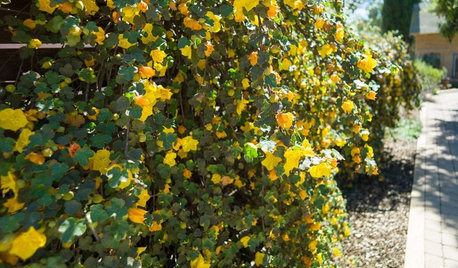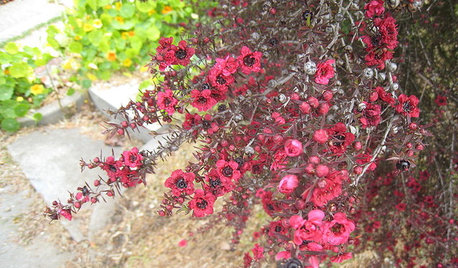(Not) pruning Teas; size of blooms
Melissa Northern Italy zone 8
8 years ago
last modified: 8 years ago
Featured Answer
Sort by:Oldest
Comments (22)
ksgreenman
8 years agocatspa_NoCA_Z9_Sunset14
8 years agolast modified: 8 years agoRelated Discussions
Pruning of Immature Tea Roses
Comments (4)Rosefolly, that is the BEST photographed and explained example I have seen of pruning, particularly "true" teas. Any others you can suggest? I am truly dumbfounded by verbal directions and really need visual guidance. However, most of the photos I find are blurry or not close enough to be able to see what's going on. Thanks for sharing this, I bookmarked it. Susan...See MorePruning climbing Teas
Comments (12)There are many variety of roses, that one can grow in a garden to beautify it. Climbing rose is one such variety, that is trained on a trellis, wall, or clambered into a tree, and when in full bloom, is one of the most delightful sights in the garden. Pruning climbing roses requires attention to maintain its healthy growth and increase the number of new sprouts. Most climbing roses need seasonal and light pruning to expose them to light and air. Here are some tips to prune climbing roses. One of the most essential requirements of pruning is a good gardening tool; a sharp pair of shears (garden scissors), in different sizes. A jagged end will damage the delicate stems, and bud growth. Climbing roses are not self-trailing, they need to be trained onto a garden trellis or a horizontal support fencing. If left to its own design, they become a tangled mess of branches with very few and unhealthy flowers. Pruning should be done any time between late autumn and late winter, as by then, the flowering season is over, and the climber has shed its leaves. It is easier to prune when the plants are bare, as they allow a better idea of its trailing route. Read more at Buzzle: http://www.buzzle.com/articles/pruning-climbing-roses-how-to-prune-climbing-roses.html Here is a link that might be useful: artificial grass orange county...See Moreforsythia blooming can I tip prune teas?
Comments (7)Just an O.T question, I was wondering which jasmine(?) you're referring to as winter jasmine over there. Over here we refer to Jasminum nudiflorum as winter jasmine, maybe it's the same over there in the US? I'm somewhat of a jasminoholic (on top of rosaholic) and I thought to ask. Another yellow vine that flowers at about this time is the so called Carolina jasmine (Gelsemium sempervirens) which is not really a Jasminum. Nik...See MoreTea Pruning
Comments (2)Looks good! Your first pic really looks like my "The Mrs" Right now - weighed down and floppy. Marleah...See Morejacqueline9CA
8 years agoBuford_NE_GA_7A
8 years agotitian1 10b Sydney
8 years agojerijen
8 years agoingrid_vc so. CA zone 9
8 years agojerijen
8 years agojardineratx
8 years agojerijen
8 years agotitian1 10b Sydney
8 years agoMelissa Northern Italy zone 8
8 years agojerijen
8 years agoBuford_NE_GA_7A
8 years agoMelissa Northern Italy zone 8
8 years agobarbarag_happy
8 years agojardineratx
8 years agoSpectrograph (NC 7b)
7 years agoSheila z8a Rogue Valley OR
7 years agoMelissa Northern Italy zone 8
7 years agosonbie
7 years ago
Related Stories

WINTER GARDENINGPruning Secrets for Exquisite Roses
Encourage gorgeous blooms year after year with this time-tested advice on how to prune your rosebush in winter for health and shape
Full Story
GARDENING GUIDESHow to Prune Your Flowering Shrubs for the Best Blooms
Less is often more when it comes to properly pruning flowering shrubs. Here’s what to do and why
Full Story
GARDENING GUIDESGreat Design Plant: Ceanothus Pleases With Nectar and Fragrant Blooms
West Coast natives: The blue flowers of drought-tolerant ceanothus draw the eye and help support local wildlife too
Full Story
GARDENING GUIDESTidy Up Sprawling Native Shrubs With These Pruning Tips
Sound horticultural pruning methods work for native and nonnative plants alike
Full Story
GARDENING GUIDESGreat Design Plant: New Zealand Tea Tree
Balance pretty polish and ruggedness in a temperate garden with this low-maintenance and drought-tolerant flowering shrub
Full Story
GARDENING GUIDESGreat Design Plant: Try Blue Bells for Blooms in Dry Soil
This shrub’s violet-blue flowers and silvery foliage brighten low-water gardens all year long
Full Story
GARDENING GUIDES10 Plants for Colorful Fall Blooms in the Drought-Tolerant Garden
Want fall color but not a big water bill? Consider these not-too-thirsty fall bloomers
Full Story
FLOWERS AND PLANTSHeat-Loving Duranta Erecta Blooms From Spring Into Early Fall
Golden dewdrops, a versatile tropical shrub, has delicate purple and white blossoms
Full Story
GARDENING GUIDESGreat Design Plant: Amelanchier Signals Spring With Airy White Blooms
With roughly 20 species of serviceberry native to the U.S., bees can feed on the early-season blooms while birds enjoy the summer berries
Full Story
NATIVE PLANTSGreat Native Plant: Grow Wild Quinine for Its Unique Clusters of Blooms
Get connoisseur cred and unique blooms with this uncommon plant. Bonus assets: It’s low maintenance and drought tolerant
Full Story








Rosefolly